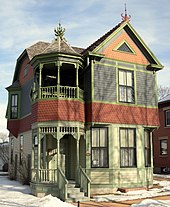New Ulm, Minnesota
The city is home to the Hermann Heights Monument, Flandrau State Park, the historic August Schell Brewing Company, and the Minnesota Music Hall of Fame.
Following a series of attacks by nativist mobs in major cities such as Chicago, Cincinnati, and Louisville, a national convention of Turners authorized the formation of a colony on the frontier.
Intending to develop a community that expressed Turner ideals, the Settlement Association joined the Chicago Germans who had struggled here due to a lack of capital.
The German Land Company hired Christian Prignitz to complete the plan for New Ulm, which was filed in April 1858.
Members were given the means to support themselves — in harmony with nature — through the distribution of four-acre garden lots located outside the residential area.
Historian Dennis Gimmestad wrote, "The founders’ goals created a community persona that sets New Ulm apart from the Minnesota towns founded by land speculators or railroad companies....
[15]On August 18, 1862, the US-Dakota War began with the attack at the Lower Sioux Agency only 30 miles up the Minnesota River from New Ulm.
As the closest significant town to the Dakota Reservation, New Ulm fell under attack by a Mdewakanton force the next day.
A hastily formed militia of armed townspeople repelled the attack and immediately set about constructing barricades around the center of the town.
Bolstered by the timely arrival of volunteer militia from other towns under Charles Flandrau, the outnumbered defenders of New Ulm again repelled the attack.
[18] Short of shelter and ammunition and facing outbreaks of disease, the majority of the population evacuated to Mankato on August 25.
Even as President Woodrow Wilson prepared his Declaration of War, a Brown County delegation arrived in Washington, D.C. to voice its opposition to that action.
The Minnesota Commission of Public Safety was granted broad powers to protect the state and assist in the war effort.
Specific actions taken by the commission included surveillance of alleged subversive activities, mobilization of opposition to labor unions and strikes (which were considered even more suspect in wartime), pursuit of draft evaders, and registration and monitoring of aliens (foreign nationals).
They filed reports to offices in Washington and St. Paul because immigrants and first-generation ethnics were suspected of having divided loyalties at best, and perhaps favoring Prussia and the Central Powers.
The people had gathered to “enter a protest against sending American soldiers to a foreign country.” Speakers included Louis Fritsche, mayor of New Ulm; Albert Pfaender, city attorney and former minority leader of the Minnesota House of Representatives; Adolph Ackermann, director of Dr. Martin Luther College; and F. H. Retzlaff, a prominent businessman.
These blows sharply divided the community — on one side, many residents took the removals as an attack on the city's heritage and traditions.
On the other side, prominent local businessmen, including flour mill managers, feared economic repercussions and promoted pro-war parades and bond drives.
[21] During World War II, German POWs were housed in a camp to the immediate southeast of New Ulm, in what is now Flandrau State Park.
[22] New Ulm Turner Hall, with the oldest section constructed in 1873, was listed in the National Register of Historic Places in 1979.
The Rathskeller features murals of scenes from Germany, painted by Guido Methua (1873), Christian Heller (1887), and Anton Gag (1901).
[23] The Brown County Historical Society, located at 2 North Broadway houses 3 floors of exhibits and one of the largest archives in the state.
Inspired by a similar monument called Hermannsdenkmal near Detmold, Germany, the figure served as a symbol for members of the Sons of Hermann, a fraternal organization of German Americans.
Through the efforts of Minnesota's 53 Sons of Hermann lodges, the monument was built in New Ulm, home to many German immigrants.
The bronze statue that rests on top of the granite base was designed and sculpted by Leopold Hafner, a German-Bohemian sculptor who now lives near Passau, Germany.
After him, other local bands such as those led by Harold Loeffelmacher, Babe Wagner, Elmer Scheid and Fezz Fritsche kept New Ulm well known around the state and region.
Polka Bands played on Minnesota Street and people danced and drank beer until well past midnight.
[citation needed] Local events held annually in New Ulm have celebrated German culture through food, music, and beer.
[28] Bock Fest, often scheduled concurrently[29] with the local festivities for Fasching, has been celebrated since 1987 at the August Schell Brewing Company.
It is also the setting of the 2009 comedy New in Town, starring Renée Zellweger and Harry Connick Jr., although the movie was actually filmed in Selkirk, Manitoba.







